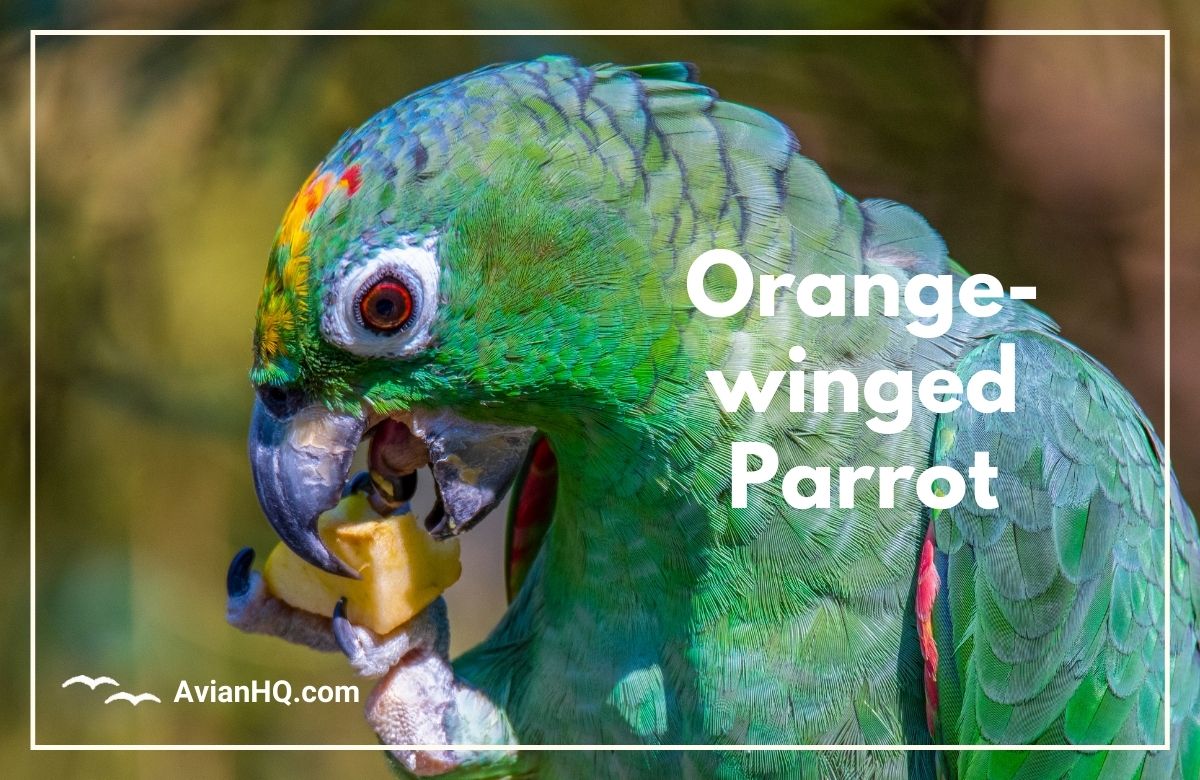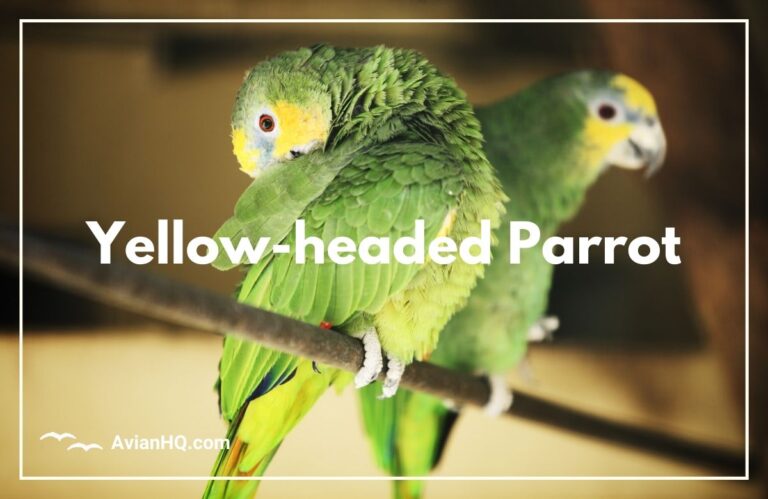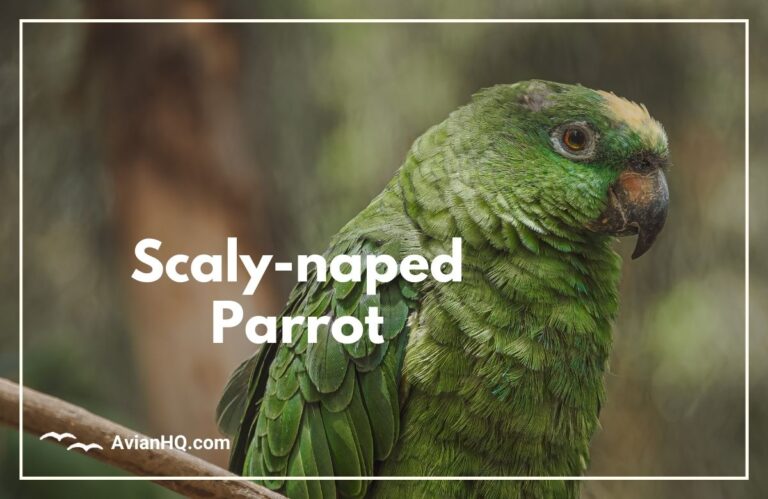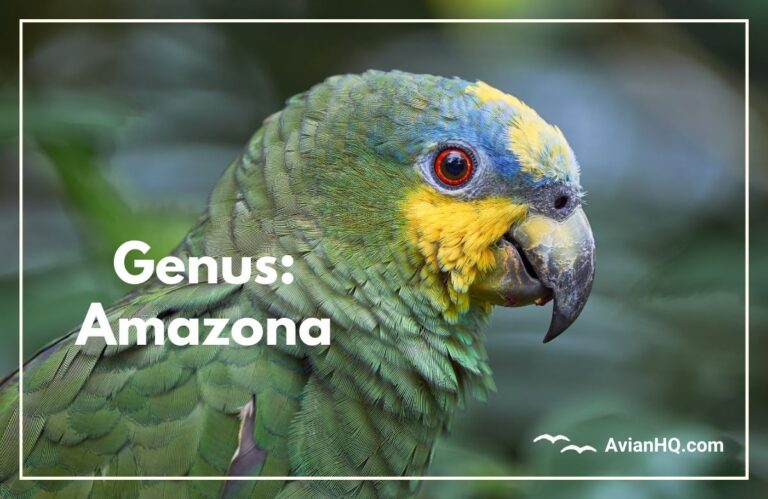Orange-winged Amazon Parrot (Amazona amazonica)
You crane your neck upward, squinting into the dense green canopy. A raucous squawking reaches your ears. You catch a flash of bright feathered wings up above as a flock of parrots bursts into flight. One parrot spreads it’s wings wide, revealing a stunning patch of fiery orange plumage. You’ve spotted the Amazon parrot known for it’s bright orange wing patches – the aptly named orange-winged Amazon.
This medium-sized rainforest parrot measures about 12-13 inches (31-33 cm) long. Its bright feathers stand out against the green backdrop of it’s tropical home. While many parrot species sport green plumage, the orange-winged Amazon lives up to it’s name with vibrant orange patches under it’s wings and across it’s tail.
The orange-winged Amazon inhabits lowland forests across much of northern and central South America. Its range stretches from as far north as Colombia down to central Brazil and over to the islands of Trinidad and Tobago. This wide distribution makes the orange-winged Amazon a common sight in the Neotropical region.
But these parrots represent more than bright bursts of color animating the rainforest. The orange-winged Amazon exhibits complex behaviors that allows it to thrive among the lush vegetation it calls home. Read on to learn more about diet, breeding ecology, conservations status and more about this charismatic tropical bird.
History and Taxonomy
The first scientific description of the orange-winged Amazon came in 1766 from the legendary taxonomist Carl Linnaeus. He assigned the bird the official name Psittacus amazonicus in the 12th edition of his influential book Systema Naturae.
The genus name Psittacus referred to parrots in general at the time. The species name amazonica relates to the Amazon rainforest where early specimens originated. We can thank the French naturalist Mathurin Jacques Brisson for providing the first description of this species in 1760 that Linnaeus later built upon.
Today, the orange-winged Amazon sits among 30 other parrots in the genus Amazona. This genus received it’s name from the French zoologist Rene Lesson in 1830. Within this genus, the orange-winged parrot is considered monotypic, meaning scientists recognize no distinct subspecies across it’s range.
Physical Appearance
The orange-winged Amazon is a medium-sized parrot, measuring about 12-13 inches (31-33 cm) long from head to tail. It typically weighs around 340 grams (12 ounces). As an Amazon parrot, it’s body displays mostly green plumage.
Splashes of color stand out on the head and wings. The forecrown and cheeks shine bright yellow. The forehead and area above the eyes glows blue. The orange namesake wings have yellow and blue highlights along the bend and edges.
When at rest, the orange undertail and wing patches remain hidden. But they flash dramatically when the parrot takes to the air. The tail consists of green central feathers tipped yellowish-green, with more orange hues underneath.
The upper half of the curved bill patterns grayish-horn while the lower mandible fades to black at the tip. The eyes blaze orange surrounded by a grayish-white eye ring. The feet and legs appear a pale gray color.
Male and female orange-winged Amazons share this vibrant palette. They look so similar that even experts struggle to tell them apart visually.
Juveniles look more subdued. Their green feathers lack some of the yellows, oranges, and blues. The irises stay a dark brown until the eyes transition to the bright orange shade of maturity.
Habitat and Distribution
The orange-winged Amazon naturally inhabits tropical regions across much of northern and central South America. Its range stretches across Colombia, Venezuela, Guyana, Suriname, French Guiana, Peru, Bolivia, and Brazil.
This parrot also dwells on the Caribbean islands of Trinidad and Tobago just off the coast of Venezuela. And thanks to the pet trade, small introduced populations have become established in Puerto Rico and the Canary Islands.
Within this expansive range, orange-winged Amazons stick mostly to lowland environments. They frequent forested areas, especially tropical rainforests, sub-tropical humid forests, gallery forests along rivers, and wooded savannas.
You may also spot these green parrots along forest edges, mangrove stands, and wooded plantations. They appear rarely above elevations of 2,600 feet (800 meters), preferring to dwell in the lush lowlands.
Their versatility allows orange-winged Amazons to thrive across diverse environments. As long as plenty of tall trees grow, they can find a home. And with such an extensive range across 11 countries, they represent the most widespread Amazon parrots across South and Central America.
Diet and Feeding
The orange-winged Amazon enjoys a diverse diet fitting for an opportunistic rainforest inhabitant. As a parrot, it relies heavily on fruit and nut resources. These include native palms, figs, and fruiting trees common across it’s range.
Favorite natural foods likely include palm fruits, golden apples, mahoe tree seeds, wild mango, and more. Their strong curved beaks and muscular tongues let them crack through the exterior to access the fleshy innards. Citrus crops like oranges get readily consumed when available as well.
Seeds and nuts also contribute. In the wild, orange-winged Amazons seem expert foragers of native vegetation. But these smart birds have realized easy meals may lie in human-cultivated fields too. Some raids on cocoa pods and other cash crops have earned them pest status in agricultural areas.
Beyond produce, orange-winged Amazons occasionally eat flower blossoms and buds for trace protein and nutrients within. Their flexible palates let these parrots thrive across many habitats and seasons.
In captivity, a diverse diet remains essential for orange-winged Amazons. Provide a quality parrot seed mix alongside bountiful fruits like apples, grapes, kiwi, and citrus. Vegetables like carrots, yams, peppers, squash and greens offer added nutrition. Ensure any human food gets supplemented to their needs. A varied, protein-rich diet will keep captive orange-wings healthy and happy.
Breeding and Reproduction
The orange-winged Amazon reaches breeding age around 4-5 years old. As spring approaches, paired couples break off to seek nesting sites. Though these parrots live abundantly across their range, suitable nesting cavities prove scarce.
Competition drives orange-winged Amazons to nest in existing hollows and holes excavated by woodpeckers and other cavity creators. The female typically selects the site, choosing large trees 130-160 feet (40-50 meters) high to call home.
Once bonded with a mate, the monogamous pairs set up shop in these wooded apartments. The female then lays a small clutch of just 2-5 eggs. These fragile white ovals measure about 1.1 inches (29 mm) long.
Only the female handles incubating duties, keeping the eggs warm for about 26 days before hatching. The male stays nearby to guard and deliver food. Those first few weeks until fledging remain dangerous, with many chicks lost to predators.
Both parents share feeding responsibilities once the helpless chicks emerge. Feather quills start emerging around 3 weeks. Then after nearly 9 weeks of growth and development, the next generation finally leaves the nest as fully-fledged juvenile parrots.
The longevity of orange-winged Amazons means bonded pairs may migrate, nest, lay eggs, and fledge chicks together for many seasons once a pair bond forms in those early years. Their fidelity serves them well raising multiple broods during their long lives.
Behavior and Ecology
The orange-winged Amazon lives up to the typical active, noisy, and social nature of it’s parrot kin. These birds use loud calls to keep connected in the dense vegetation of their forest home. That familiar raucous squawking that bombarded your ears from the canopy comes courtesy of their efficient communication system.
Roosting and foraging behaviors also strengthen social bonds. Orange-winged Amazons gather in large communal roosts before nightfall, sometimes numbering several hundred birds at a time. Loud screeches fill the air as the talkative flock settles in the trees. At dawn, renewed noisy dialogue accompanies their departure to feed.
During daytime hours, orange-winged Amazons forage fruit groves in smaller groups of 10-50 in the canopy. Several family groups may converge on a feeding area, allowing these parrots to learn new food sources from each other. Their high degree of sociality likely serves an important purpose for survival across the generations.
Interactions extend beyond their own species as well in mixed flocks. Blue-fronted Amazons frequently flock together with orange-wings who share parts of their range. Other parrots like macaws, conures, and toucans often team up while foraging too. The orange-winged Amazon thrives thanks to it’s diverse community bonds.
Conservation Status
The orange-winged Amazon enjoys a broad range across much of South and Central America. Within this extensive boundaries, fairly large and numerous populations exist to sustain this species.
As such, the International Union for the Conservation of Nature (IUCN) Red List categorizes the orange-winged Amazon as Least Concern. Its expansive range and large total population offers optimism for it’s future welfare.
Yet as an abundant, colorful parrot, major threats impact local and regional populations:
- Pet Trade Over-Harvesting: As many as 66,000 orange-winged Amazons entered international trade legally from 1981-1985 alone. Continued trapping pressures for the pet industry pose extreme dangers.
- Hunting: Local cultures legally and illegally hunt orange-wings for food and feathers across parts of it’s range.
- Persecution as Agricultural Pests: Farmers often view crop-raiding flocks as nuisance wildlife to control.
- Habitat Loss: Deforestation reduces available old-growth nesting and foraging sites.
While the species currently appears in no danger as a whole, conservation actions must reduce trapping levels while protecting rainforest habitats to ensure healthy, sustainable orange-winged Amazon numbers for the future.
Cultural Significance
The orange-winged Amazon holds a special place in human culture thanks to it’s intelligence and attractive appearance. Their popularity in the pet trade stems from these parrots’ affectionate nature, playfulness, and ability to learn simple words and phrases.
Historically, many indigenous South American peoples incorporated these abundant green parrots into myths, legends, and healing practices. Tribes like the Yanomami link the orange-winged Amazon to stories explaining natural phenomena. Shamanic rituals may use it’s feathers or other body parts for traditional medicine.
Within the regions it inhabits, rural farmers and tribes legally hunt orange-winged Amazons as a protein source to feed families. More concerning is the illegal poaching for feathers and meat amid deforestation. Though culturally ingrained for centuries, such practices now threaten local populations.
While a long history of use and coexistence exists between this species and South American cultures, outreach programs emphasizing sustainable harvesting may help conserve orange-winged Amazons. Their value as a vital economic resource via ecotourism and regulated habitat protection offers an alternate path going forward.
Conclusion
The orange-winged Amazon remains an icon of the South American rainforests it’s inhabitants. Those vibrant splashes of color – it’s namesake orange wings and tail, bright yellow and blue crowns – stand out even amid the diverse tropical palette.
Yet beyond it’s beauty, this Amazon parrot symbolizes the delicate balance of rainforest ecology through it’s relationships, adaptations, and durability across a challenging landscape.
While less endangered compared to other tropical species, the orange-winged Amazon faces uncertain pressures from habitat loss and overharvesting in an ever-changing 21st century world.
As stewards of biodiversity, perhaps we can draw inspiration from it’s wild nature. If this rainforest ambassador can continue thriving enough to brighten forest treetops for decades to come, the future looks brighter for us all.







